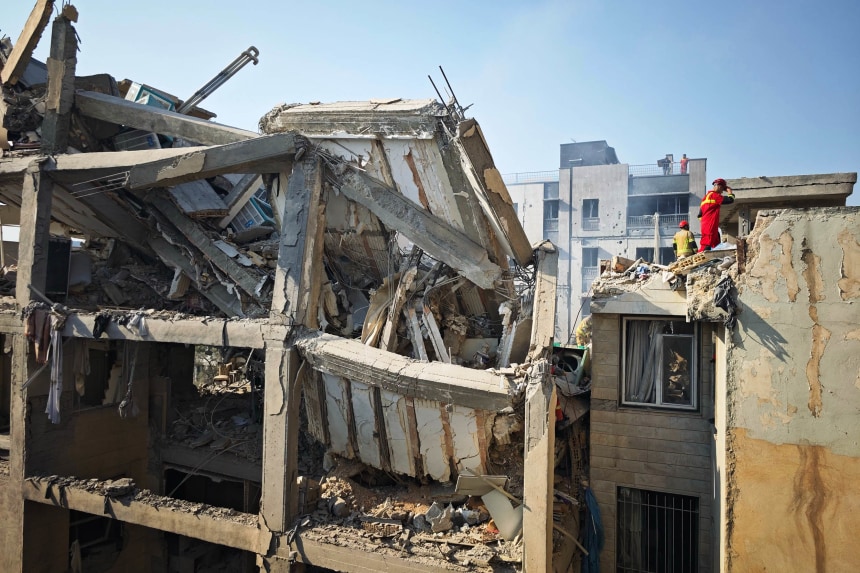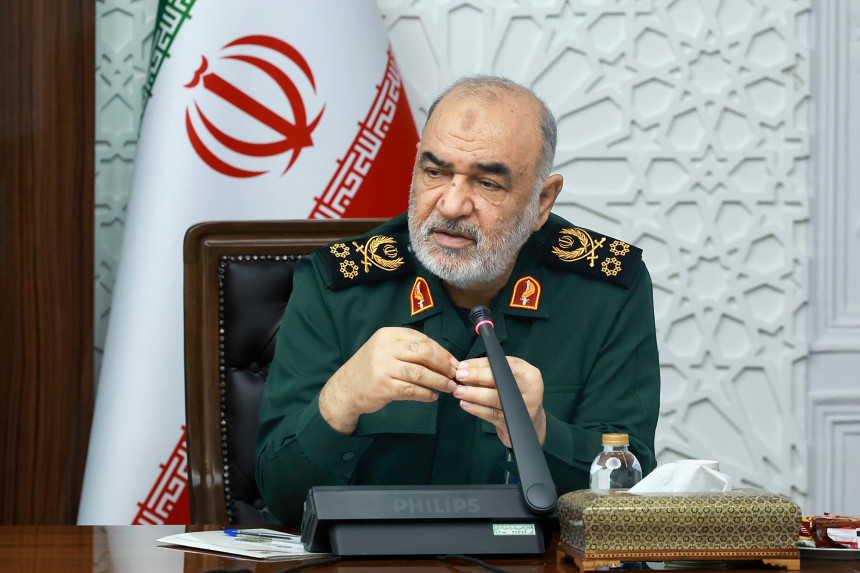The Israeli military launched the attack on Friday June 12, in response to alleged threats from Iran and its proxies in the region. The targeted strikes aimed to weaken Iran’s military capabilities and send a strong message to Tehran. The situation remains tense as both sides brace for further retaliation and potential escalation of hostilities.
The strikes took out a significant swath of Iran’s top military leaders and senior scientists, as Israel unleashed more than 200 fighter jets across roughly 100 targets. They were aimed at Iran’s main enrichment facility and targets associated with the country’s ballistic missile program, Israeli Prime Minister Benjamin Netanyahu said. The targeted strikes have raised concerns about potential retaliatory actions from Iran and its allies in the region.
The strikes resulted in the deaths of almost 80 individuals and left over 300 people wounded in Tehran, as reported by the semiofficial Fars news agency. While Iranian officials have not officially verified these figures, it was noted that residential buildings were also impacted by the attacks.
Supreme Leader Ayatollah Ali Khamenei swiftly vowed retaliation. Soon after the strikes, Iran launched more than 100 drones toward Israel, Israeli Brig. Gen. Effie Defrin said. In response to this escalation, Israel activated its Iron Dome defense system to intercept and neutralize the incoming threats.

Iran has long denied it is seeking to develop nuclear weapons. The United States, which had been publicly urging Israel to hold off on such an attack as the Trump administration continues talks with Iran on its rapidly advancing nuclear program, said it was not involved and was not providing assistance. But President Donald Trump told NBC News in an interview Friday he was pleased with the manner in which the strikes were conducted. “They had the finest equipment in the world, which is American equipment,” he said. Additionally, the United Nations Security Council is scheduled to meet in the coming days to address the escalating tensions between Israel and Iran, with many countries calling for a de-escalation of the conflict.
The International Atomic Energy Agency, the United Nations’ nuclear watchdog, reported that Iranian authorities confirmed the strike on Natanz, Iran’s largest nuclear site in the central Isfahan province. However, no increase in radiation levels was observed at the site. Israeli Brig. Gen. Effie Defrin confirmed that the attack targeted a critical underground area of Natanz, causing significant damage to its infrastructure. The Fordow, Isfahan, and Bushehr nuclear sites were reported to be unimpacted by the strikes, according to the International Atomic Energy Agency.
Other targets appeared to be residential compounds for top military officials. A main building for Iran’s Islamic Revolutionary Guard Corps (IRGC), founded in the aftermath of the 1979 Islamic Revolution to defend the regime against internal and external threats, also appeared to have been attacked and could be seen burning on state television. In addition, reports from sources on the ground suggest that several key research and development facilities linked to Iran’s defense industry were also targeted in the strikes, leading to significant destruction and casualties.
Bagheri’s death has sent shockwaves through Iran’s military and political circles, leading to fears of further instability and retaliation from Tehran. His role as chief of staff of the Iranian armed forces was crucial in shaping Iran’s military strategies and responses to external threats. The loss of such a high-ranking official is expected to have significant implications for Iran’s military command structure and overall defense capabilities.
The Shahid Beheshti University in Tehran reported that at least five professors from the school’s community, including nuclear scientist Mohammad-Mehdi Tehranchi, were killed in the targeted strikes. The university also mentioned that some family members of the professors were among the casualties, although their identities and further details were not disclosed.
Other key figures targeted and killed in Friday’s strikes included Hossein Salami, the commander in chief of the IRGC, as reported by the force’s media arm. Additionally, Maj. Gen. Gholam Ali Rashid, a high-ranking official in the IRGC; Fereydoon Abbasi, a prominent nuclear scientist and former head of Iran’s Atomic Energy Organization; and Mohammed Mehdi Tehranchi, also a respected nuclear scientist, were confirmed among the casualties by Iranian state media sources.
Iran blames the U.S.
Earlier Friday, Trump emphasized that he had repeatedly offered Iran opportunities to negotiate a deal. In a statement on Truth Social, he underscored the necessity for Iran to engage in discussions and salvage what remains of the historic Iranian Empire before it’s too late.

However, despite these statements, tensions between the two nations continue to escalate, with both sides seemingly preparing for further confrontation.
Trump hinted at the possibility of potential talks with Iranian officials, mentioning that there have been contacts from individuals seeking discussions, although he did not disclose specific names or details.
Despite the scuttling of the scheduled sixth round of nuclear talks with Iran in Oman, Israel’s strikes seemed to mark a significant departure from the Trump administration’s approach. The strikes caused Iran to announce through state TV on Friday that they would not participate in the talks. However, a U.S. official responded by expressing hope that talks could still take place despite the escalating tensions between the two nations.
A major concern for the U.S. is the potential for Iran to retaliate against American personnel or assets in the region. Following the initiation of the Israeli attack, the State Department issued guidance for employees at the U.S. Embassy in Israel and their families to remain in secure locations.
Secretary of State Marco Rubio said the U.S. was not involved in strikes and its “top priority” was protecting American forces in the region.
“Let me be clear: Iran should not target U.S. interests or personnel,” he said.
Rubio also emphasized that Israeli officials had conveyed to Washington that the attack was deemed as “necessary for its self-defense.”
While the U.S. said Israel had acted unilaterally, Iranian Foreign Minister Abbas Araghchi said the attack could not have happened “without the coordination and approval of the United States.” “The American government, as the main supporter of this regime, is also responsible for the dangerous consequences of these actions,” he said. U.S. officials had earlier announced the voluntary departure of nonessential employees from the region.
Israel and Iran have been engaged in a protracted rivalry and conflict following the 1979 Islamic Revolution. This ongoing feud has often manifested itself through Tehran’s support of proxy groups in the region. Over the years, Israel has conducted preemptive strikes on Iran’s allies to hinder their acquisition of advanced weaponry. Additionally, both nations have targeted each other’s maritime assets in acts of aggression at sea.
The terrorist attack on October 7, orchestrated by Hamas, resulted in the deaths of several Israeli civilians and military personnel. The attack, which targeted a crowded market in Tel Aviv, led to widespread chaos and devastation in the area. Israeli Prime Minister Benjamin Netanyahu swiftly condemned the attack, vowing to take decisive action against those responsible. The Israeli Defense Forces have been placed on high alert, with increased security measures across the country to prevent further attacks. The international community has also expressed solidarity with Israel in the wake of this heinous act of terrorism.
This attack intensified the ongoing conflict between Israel and Iran. This was further exacerbated by the subsequent military campaign in Gaza, where Iran provides support to Hamas and positions itself as a key advocate for the Palestinian cause on the global stage.
Israel intensified its focus on targeting Iran as tensions rose with Washington and Tehran moving closer to a preliminary agreement. The International Atomic Energy Agency’s board of governors recently declared that Iran is violating its nuclear obligations, marking the first time in two decades. This fueled Israel’s determination to take decisive action against the perceived threat posed by Iran’s nuclear ambitions.
IAEA Director General Rafael Grossi stated on X that the organization is closely monitoring the “deeply concerning” situation. Subsequently, he confirmed that Iranian authorities had informed the agency that the Bushehr nuclear power plant was not among the targets and that there had been no recorded rise in radiation levels at Natanz.
“I have repeatedly stated that nuclear facilities must never be attacked … as it could harm both people and the environment,” Grossi said in a separate statement published on the IAEA’s website. Additionally, he emphasized the importance of upholding international norms and agreements in order to prevent further escalation of tensions in the region.
Israel and Iran clashed in October, with the conflict escalating after an Iranian attack on Israel followed by Israel’s strike on Lebanon, resulting in the death of Hassan Nasrallah, the leader of Hezbollah backed by Iran. Reports indicate that the majority of the 200 missiles launched by Iran towards Israel were successfully intercepted.
Israel responded with three waves of strikes on Iranian military sites, though it avoided nuclear and oil facilities in what appeared to be a limited attack. The strikes targeted key military installations and bases, including command centers and weapon storage facilities, further escalating tensions between the two nations. The Israeli military emphasized that the strikes were necessary to defend against perceived threats from Iran and its proxies in the region. As both sides continue to brace for potential retaliation, the situation remains volatile and unpredictable.
[mwai_discussions id=”default”]
